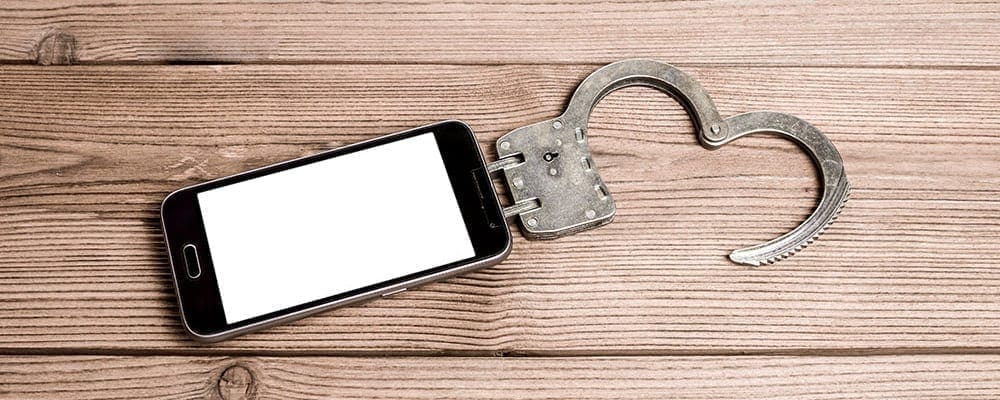Statistics say that around 6.3% of the 3.8 billion smartphone users today suffer from cell phone addiction.
Smartphones are great in so many ways. But, like many technologies, they’re a double-edged sword. The downside? We’re becoming so reliant on them that both our physical and mental health is suffering.
Right now, we’re in a situation where cell phone addiction is ever-increasing, and so is our daily EMF exposure. What does this mean for our near future?
Recent reports provide some alarming insights into our nation’s smartphone habits. So, it may be now time to ask yourself: Are your cell phone habits putting your health at risk? And if so, what can you do about it?
Later in this post, we’ll look at ways you can minimize your cell phone addiction without having to ditch your smartphones altogether. But first…
Are We Becoming Addicted to Our Smartphones?
In 2019, Common Sense Media reported the cell phone usage stats in teenagers and their parents. This study revealed that 45% of parents feel addicted to their mobile devices.

Want to Slash Your EMF Health Risks?
Want to Slash Your EMF Health Risks?
Good! Learn the one small change you should make right now.
In 2016, less than a third of parents reported spending too much time on their mobile devices. That number has now risen to more than half. And the number of children who think their parents are addicted to their smartphones also significantly increased.
In these studies, both kids and their parents reported that their cell phone addiction is affecting their family relationships.
But that’s not the only thing that’s concerning.
According to the same report, 36% of teens wake up at least once at night to check their phones. And 29% of teens sleep with their mobile devices in the bed with them.
This is worrying on several fronts.
Studies already show that light from screens interferes with melatonin production and decreases sleep quality. When the “fear of missing out” keeps teenagers checking their phones before bed and during the night, it’s bound to affect their health adversely.
Moreover, keeping their phones in bed means they’re being exposed to electromagnetic radiationElectromagnetic radiation refers to the waves of the electromagnetic field, propagating through space, carrying electromagnetic radiant energy. It includes a wide range of electromagnetic waves, from very long radio waves... at close distances, 24/7, without a break.
For developing brains and bodies, this is particularly worrisome.
What Are the Health Effects of Smartphone Overuse?
The longer we spend glued to our smartphones, the longer becomes the list of adverse health effects we suffer as a result. These health effects are both physical and mental. Have a look.
Damaged Memory
Research studies have found that prolonged cell phone use deteriorates memory performance, especially in the younger population.
A 2020 study by the Swiss Tropical and Public Health Institute (Swiss TPH) says that RF-EMF affects cognitive functions by interfering with several brain regions exposed during mobile phone use.
This study, which ran for one year, analyzed the data collected from over 650 Swiss teenagers to understand the changes EMF exposure makes to their memory performance.
The researchers concluded the study by saying that “cumulative RF-EMF brain exposure from mobile phone use over one year may have a negative effect on the development of figural memory performance in adolescents.”
Impatience
Patience is becoming a scarce skill in this era of modern technology and high-speed internet. In 2019, stationery supply company BIC commissioned a research study in which they uncovered some precious insights into the patience limits of 2,000 UK residents.
This study revealed that there was a rise in the majority of volunteers’ frustration levels after waiting:
- 16 seconds for a webpage to load
- 25 seconds for a traffic signal to change from red to green
- 20 seconds for ink to dry on a greeting card
- 22 seconds for a movie to start streaming
- 18 seconds looking for a pen
- 28 seconds for a kettle to boil
As technology has brought everything to our fingertips, we have become habituated to instant gratification, meaning we’ve lost our ability to wait.
Instant Gratification Addiction
A 2016 research study by Temple University showed how today’s tech-based generation has difficulty accepting delayed gratification.
The researchers gathered 91 undergraduate students for this study and asked them to fulfill a questionnaire. The questionnaire included questions to understand the amount of time they used their cell phones to check social media updates, post their own updates, or do simple checks to see if they missed anything.
Besides that, they also set the questions to assess the student’s capability to accept delayed gratification. They were asked if they’d like to receive a small amount of money instantly or a larger sum later.
After this survey, the researcher found that people who use their cell phones more are likely to go for instant gratification than receive a much more satisfying delayed gratification after waiting for some time.
Henry Wilmer, the lead researcher in this study, said that “mobile technology habits, such as frequent checking, seem to be driven most strongly by uncontrolled impulses and not by the desire to pursue rewards.”
Jason Chein, the second researcher in this study, added that “the findings provide important insights regarding the individual difference factors that relate to technology engagement. These findings are consistent with the common perception that frequent smartphone use goes hand in hand with impatience and impulsivity.”
Decreased Ability to Think
Prolonged smartphone use affects our cognition, making us more dependent on the device, says Neurologist Dan Kaufer, MD.
“With smartphones, you have a whole encyclopedia and beyond of information at your fingertips at any point in time. But this results in a much more superficial or shallow way to access information,” Dr. Kaufer said. “The more we rely on these types of information aids or sources, the less work and processing our brains actually do.”
This means that because of smartphones, our brains don’t have to work hard to obtain information. And this causes us to slowly lose our ability to think deeply.
For example, say you’re reading a book. Your brain creates images of the characters, places, and objects described in the book.
“That involves making connections between different parts of your brain,” says Dr. Kaufer. But “when you look at a picture that is already there, it’s much more passive. You’re not working [as many] parts of your brain.”
Low Focus & Attention: Digital Overstimulation
Studies say that today the average human attention span is just 8.25 seconds. That’s a decrease of 3.5 seconds from merely two decades ago.
A solid attention span is critical as it’s the gateway to deep thinking. A diminished attention span causes your cognitive functions to suffer, affecting:
- Memory
- Perception
- Language
- Creativity
- Learning
- Decision-making
- Reasoning and problem solving
Research says that cell phone addiction takes a huge toll on your attention span as it overloads your brain with information, so you can’t focus on what’s happening around you.
Isolation
A research study by the San Francisco State University found that “the behavioral addiction of smartphone use begins forming neurological connections in the brain in ways similar to how opioid addiction is experienced by people taking Oxycontin for pain relief — gradually.”
Cell phones set you in a virtual life that’s more interesting and stimulating than the real one. This is why cell phone addiction sufferers also suffer from isolation. Since they have everything they need at their fingertips, they have no incentive to go out in the world and do things offline.
The researchers found that the students that used their phones the most reported feeling lonelier and more isolated than their peers who were less dependent on their devices.
And More…
These are just the tip of the iceberg, as smartphones not only make you less efficient but can also severely affect your mental health.
Research studies have linked prolonged smartphone use with problems like depression, anxiety, and other mental health issues. Read my in-depth post on tech addiction for more information.
Physical Effects
As I already mentioned, cellphone overuse affects you both physically and mentally.
When you constantly tap, scroll and type, it can cause problems like wrist pain, carpal tunnel syndrome, and tendinitis of the hands and fingers (so common to have earned the nickname “text claw”).
Even the simple act of looking down at your phone is the equivalent of supporting a 60-pound weight with your neck—not an easy thing on your spine (to put it lightly).
But perhaps the most prominent health concern of all is our growing exposure to electromagnetic radiation"Radiation" in the context of Electromagnetic Fields (EMF) refers to the process by which energy is emitted and transmitted through space or a material medium in the form of electromagnetic.... Though cell phone radiation has already been linked to increases in certain types of cancers, issues with fertility, and more, the long-term effects will only become fully apparent as the current generation of smartphone users age.
Obesity
“As smartphones continue to be an inherent part of life and grow as a primary source of entertainment—particularly among young people—it leads to a decrease in physical activity,” says a research study by the American College of Cardiology.
Although modern technology has made our lives significantly more convenient, our bodies follow the same 200,000-year-old DNA codes that evolution wrote for us. Our bodies are designed to be physically active. They’re designed for hunting, running from predators, and doing physical labor to survive.
And when we don’t give them the physical activities required, we face problems like obesity.
In the United States, more than 2 in 5 adults (42.4%) suffer from obesity. And lack of activity induced by cell phone addiction is one of the contributing factors.
Sleep Deficit
Cell phones (or any devices with screens, for that matter) emit something called blue light. We’re exposed to blue light daily from the sun. It’s what your body uses to regulate your circadian rhythm.
Before LED screens, the sun was the only source of blue light. So, our bodies are set to switch to active mode when we see blue light.

Nowadays, we don’t stop exposing our eyes to blue light even after sundown. And this is a huge problem because our brains don’t get the signal that it’s nighttime and we need to rest.
This can cause you to stay awake, not getting your recommended 7-9 hours of restful sleep. And even when you manage to shut your eyes after hours of tossing and turning, the sleep quality you get won’t be optimal.
Learn more about the effects of blue light on your health in my post, “What Is Blue Light? Is Blue Light From Electronic Gadgets Bad for Your Health?”
Do Phones Have Radiation?
Yes. Cell phones have radiation. In fact, it’s essential for their function. That’s how your cell phone communicates with the network tower and allows you to make calls and texts and use the internet wirelessly.
And if we look at the thousands of research studies on the subject, it’s clear that this radiation harms your physical and mental health.
Studies say that prolonged EMF exposure causes health problems ranging from minor sleep disorders to chronic diseases like cancer.
Cell phone addiction adds a new dimension to this problem.
See, the more you use your cell phone, the longer you’re exposed to its EMF emissions. And in a stretched-out period, the accumulated EMF can cause significant damage.
Cell Phone Addiction and EMF: Exposure Is Cumulative
So, how much time do we spend on our mobile devices?
Most sources put average daily use by US consumers at between 3 and 5 hours per day. And according to BankMyCell, the average smartphone user, per day, checks their device at least 47 times.
Now consider that these habits are being formed from an increasingly young age.
A study on the lives of Generation Z found that 25% had a smartphone before age 10.
If the trends in the statistics above continue, more and more people will have their phones right next to their bodies all day and all night, even as they sleep. And more of them will be addicted to their devices by the time they reach adulthood.
Their cumulative exposure to electromagnetic fields will be unprecedented. And that’s without even considering their constant exposure to ambient EMFs like WiFi networks and the impending rise of 5G “small cell” towers.
What Can You Do to Protect Your Health?
All of this is not to suggest that your cell phone is trying to kill you, and you should throw it out the window.
What I want to point out is that smartphone use is increasing. Many people now feel that they can’t live without their mobile devices.
The adverse effects of cell phones aren’t a secret anymore.
So, when you put two and two together, the outcome is simple to predict. Increased use of cell phones equals an increase in health problems.
So, what can you do to protect yourself?
Limit Your Cell Phone Use
When you add limits to your cell phone use, it will not only protect you from a number of EMF and non-EMF-induced health problems, but it will also free up time that you can use to do things that actually matter.
But how do you limit your use?
- Turn off unnecessary notifications. Stop apps from prompting you to check your phone more than you need to.
- Whenever possible, keep your phone away from your body. Putting it across the room has the double advantage of distancing you from radiation and making it less tempting to use it so much.
- Don’t sleep with your phone next to your head. Or, if you do, turn it onto airplane mode so it’s not emitting radiation. This also prevents it from waking you with notifications.
- Set some guidelines for device use at home and with family. For example, make it a rule not to use devices during mealtimes.
Digital Detox
Digital detox is one of the best ways to alleviate cell phone addiction. This is a simple concept in which you ditch your electronic gadgets for a specific period to allow yourself time to reconnect with the real world.
There are many ways you can practice digital detox. Some people take tech-less vacations, and some assign one day a week to digital detox. But you don’t have to go that far if you don’t have the time.
The best thing about digital detox is that it’s flexible. Learn more about the many ways of practicing digital detox in my post, “Digital Detox: How & Why to Take a Break From Technology.”
EMF Protection
The reality is that even if you can prevent “text claw” by typing less, it’s near impossible to avoid the increasing number of electromagnetic fields that exist all around us.
There are many ways you can protect yourself and your loved ones from EMF’s adverse effects. And most of them are simple to implement and will cost you nothing. I’ve written all about it in my “EMF Healthy Living Tips” post collection. So, give it a read.
For times when you really must use your devices, you can mitigate your EMF exposure by getting yourself lab-tested EMF protection products based on your requirements.
Shield Your Body makes and sells such products to help you enjoy the benefits that tech brings without risking your health and well-being. So, check out the SYB Store.
Final Thoughts
With cell phone addiction and EMF exposure both on the rise, the amount of radiation we absorb is increasing exponentially with each generation. That’s why protecting both yourself and your family is worth it.
Start now. Your future self will thank you for it.












